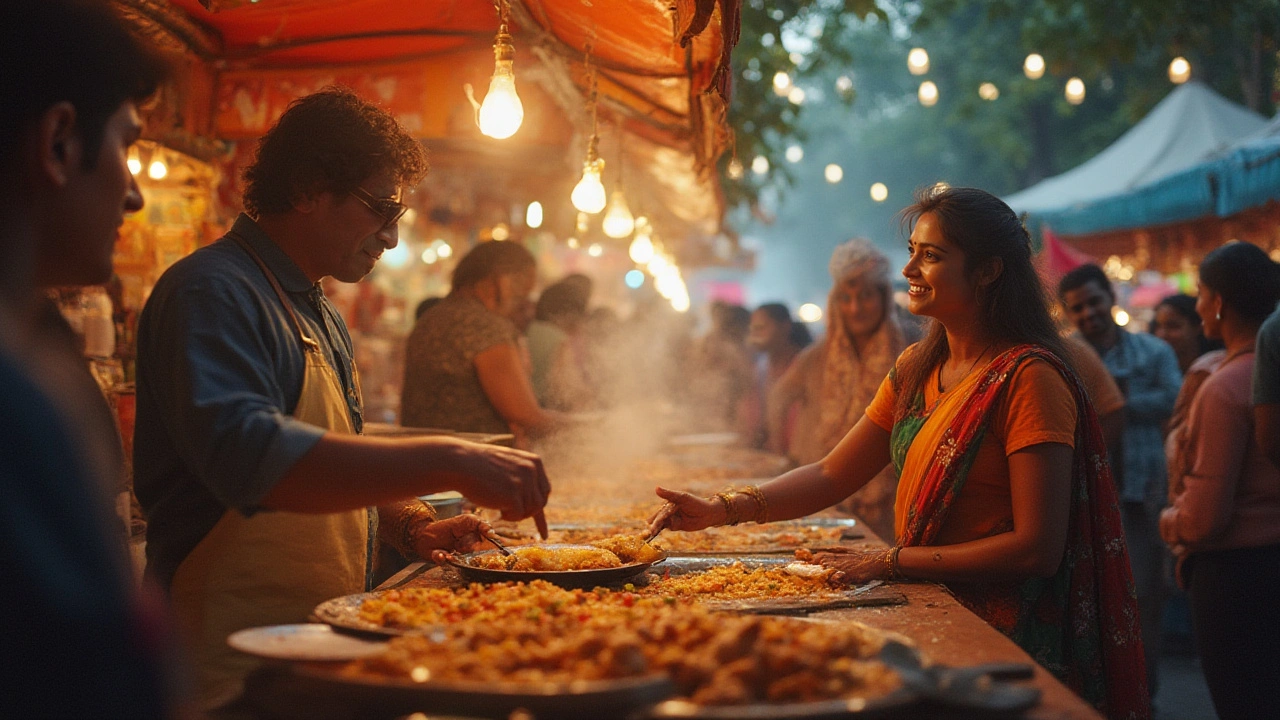Indian Street Food – Spicy Must-Try Dishes You’ll Crave: Your Comprehensive Guide
Picture this: busy streets in Delhi, the smell of frying dough, the quick hammer of a bangle seller’s hands – and suddenly, a plate of spicy chaat appears in your hands, as if by magic. Indian street food isn’t just something you eat; it’s a living, breathing part of daily life that makes you pay attention. You can taste the country’s pulse in every bite, whether it burns your tongue or leaves you running for a sweet lassi. From tangy pani puri to rich samosas bursting with spiced potato, there’s nothing else quite like it. Foodies love its thrilling unpredictability: the next bite could be a perfect blend, or a little too fiery, but always memorable. Think of it as India’s edible adventure – spicy, vibrant, and impossible to forget. We’re diving into the origins, must-try dishes, handy etiquette tips, and need-to-know advice so you can make smart choices and feast like a local.
Understanding the Basics of Indian Street Food
Origins and History
Indian street food sits at the crossroads of tradition and invention. Its roots stretch back centuries, entwined with bustling trade routes and local markets that popped up wherever people gathered. Chaat, for example, was originally created in Uttar Pradesh centuries ago as a healing dish for digestive trouble (and ended up capturing the hearts of millions). Many snacks came from royal kitchens, only to go rogue and find a second life on the street – think aloo tikki from Mughal-era kitchens or jalebi’s sweet spiral tracing back centuries. What makes street food special is its locally-sourced ingredients, small-batch techniques, and the way vendors improvise recipes to suit what’s available. Every region gives its snacks a unique spin; a vada pav in Mumbai tastes nothing like one in Chennai, and that’s half the fun.
Core Principles or Components
Here’s what matters: speed, bold flavour, and community. Dishes are served fresh, usually right in front of you, hot and crackling from the pan. Spices are the backbone: cumin, coriander, chaat masala, chili, turmeric, and garam masala each bring their own magic. Many favourites use humble ingredients – potatoes, chickpeas, lentils, onions – but it’s the aromatics, sauces, and crunch that win you over. Don’t underestimate the chutneys, either; from spicy mint to sweet tamarind, they tie everything together. There’s usually a vegetarian base, though non-veg snacks are popular in some cities. Most street food is bite-sized, easy to eat while standing with friends, handing bowls around, and debating who got the best bite.
How It Differs from Related Practices
Street food stands apart from casual restaurant fare or home-cooked Indian food. It’s fast, interactive, and never the same twice. Restaurants serve similar dishes, but theirs tend to be milder, more predictable, and formal. At home, these snacks are labor-intensive and rarely taste as zingy – maybe it’s the fiery oil, open flames, or pure street energy. Indian street food also means sharing space with crowds, hawkers, street noise, and chaos, while restaurants are quieter affairs. Here’s a table for clarity:
| Practice | Key Feature | Primary Benefit |
|---|---|---|
| Street Food | Fresh, made-to-order, high spice | Bold flavors and instant satisfaction |
| Restaurant Snacks | Milder flavor, sit-down | Consistency, comfort, controlled spice |
| Home Cooking | Labor-intensive, family recipes | Tailored to health and preference |
Who Can Benefit from Indian Street Food?
If you love adventure or need a quick meal on the go, you’re right at home with Indian snacks. Locals, tourists, and anyone craving flavor all dig in. Some choose it because it's cheap and filling – you can eat well for a pocketful of coins – while others travel the city searching for legendary pani puri or the perfect masala dosa. Vegetarians will be spoiled for choice, but meat lovers have options too. It draws people who want to expand their spice tolerance, or those who just want a finger-licking treat (pack tissues!). No matter your food background, there’s a spot at the table. If you’re new, start with aloo tikki or bhel puri before jumping to the super-spicy stuff.
Benefits of Indian Street Food for Your Tastebuds and Beyond
Benefit 1: Expands Your Palate
Let’s not pretend: eating your way through India’s streets is like turning up your tastebuds to eleven. Layers of spices, unexpected sour-sweet combos, hints of char and crunch – every dish is a masterclass in flavor balancing. Individuals who enjoy exploring new foods will find their palates broadened, often discovering likes they didn’t expect. Indian street food is also naturally rich in plant-based foods (potatoes, legumes, vegetables), giving you healthier options if you skip the deep-fried treats. Plus, you get a crash course in how spices work together; after a few tries, you might start noticing the differences between black salt and regular salt or the reason tamarind makes your mouth water.
Benefit 2: Connects You to Culture
Sharing street food is an act of community. It’s about meeting as equals in a queue, swapping tips for the best pani puri wallah, and passing samosas around with friends or strangers. You learn a lot about regional traditions and local pride by tasting their snacks; even bargaining for extra chutney can be an adventure. Some historians believe street stalls are where old social barriers broke down, thanks to food’s universal draw. Watching a skilled chaat vendor assemble your order becomes a mini cooking lesson, often with a side of friendly banter or stories about secret family spice blends.
Benefit 3: Affordable Indulgence
Shockingly low prices make regular street food feasts possible for all sorts of people. Top-earning professionals line up next to daily wage workers, all reaching for the same pav bhaji at a fraction of restaurant prices. Despite fast service, you’re rarely rushed. For students, travelers, or larger families, this makes sampling multiple snacks in one evening easy —way better than sticking to starters at a fancier joint. Don’t forget the thrill of getting so much flavor for so little cost; it’s almost a superpower in itself!
Benefit 4: Versatility for Every Preference
There’s a dish for every craving: crunchy, spicy, sweet, sour, or creamy. Whether you eat vegan, partial to gluten, allergic to nuts, or strict about Halal, most vendors can suggest something for you (just ask and explain your needs). Because ingredients are mixed fresh, you can often ask them to dial spice up or down. Trying street food helps picky eaters get a bit braver, too. Here’s a table to make sense of the key benefits:
| Benefit | Description | Impact |
|---|---|---|
| Flavor Expansion | Spices, textures, heat, tang | Keeps meals exciting and new |
| Cultural Immersion | Eating as locals do, sharing space | Makes travel and communities richer |
| Affordability | Low cost, large variety | Accessible for all budgets |
| Dietary Options | Fresh prep, customizable | Suits many dietary needs |
What to Expect When Enjoying Indian Street Food
Setting or Context
Expect a high-energy environment. Stalls and carts pop up near bus stations, railway platforms, or bustling neighborhood markets. You’ll probably stand around a cart squeezed between other food lovers, the air swirling with cardamom and fried spices. Seating is rare, maybe a bench if you’re lucky; most feast standing up, chatting or eating elbow-to-elbow. Vendors cook right in front of you, often using well-seasoned tavas (griddles) or deep frying in bubbling oil. It’s less about hygiene theatre—though good stalls are very clean—and more about showmanship and freshness. Don’t be surprised if people tap you to ask for your verdict on a dahi puri or sneak a quick bite from your plate (it’s all in good fun).
Key Processes or Steps
The magic unfolds fast: first, you watch as crispy shells are filled, sauces ladled, and toppings tossed on. Many dishes (like chaat, bhel puri, or sev puri) are assembled only when you order. Fried snacks come piping hot, and sauces are dolloped on at lightning speed. Enjoying your food means using your hands – spoons and plates are available, but street style usually means biting straight into a puri before it gets soggy. Don’t rush; savor the first bite, talk between flavours, and chase the heat with fresh lassi or a cube of sugarcane. Watch out for the surprise chili, though—it’s a taste test of bravery sometimes!
Customization Options
The power is yours: “less chili,” “extra onion,” “sweet chutney only,” or “hold the sev.” Street vendors are masters at customizing each portion, usually at no extra charge. Just be polite and clear about your needs. If you’re sensitive to spice, say “thoda teekha” (less spicy) or “bina mirch” (no chilli) in Hindi. Gluten intolerance? Try chana chaat or simple sweet corn. Vegan? Look out for butter or yogurt; most can swap these for plant-based sauces if you ask. This mix-and-match aspect is part of the street food fun and ensures everyone gets a taste they’ll crave again.
Communication and Preparation
Some vendors speak basic English, but knowing a few phrases keeps things smooth. Pointing at dishes is normal, as is asking what’s fresh. Clean water or wipes can help before digging in. Locals often follow the busiest stalls (it’s a good freshness/hygiene signal). Carry small change—it speeds things up and makes you a popular customer. If you have allergies or dietary needs, write them down in the local language, or stick to cooked/fried options where ingredients are visible. Prep your stomach for spice adventures, and have a sweet drink or yogurt close at hand!
How to Embrace Indian Street Food the Smart Way
Setting Up for Success
Find a lively area with steady crowds; turnover means the food won’t linger too long. Bring hand sanitizer and tissues for quick clean-ups. Wear comfy shoes and clothes that can take a bit of splatter—food is delicious but rarely neat. For rainy days, pack a small umbrella; some of the best snacks appear when weather cools the air and brings people together under canvas sheets.
Choosing the Right Vendors
Look for vendors with queues—locals always know the best spots. See how ingredients are stored (covered trays, fresh sauces, clean counters). Watch how money and food get handled; a vendor who serves with one hand and handles cash with another is a green flag. Ask other buyers what’s best or freshest today. Good stalls display awards, press articles, or “since 1995” signs with pride; these are often tastier and better maintained. If you see vendors wearing gloves or hair caps, that’s extra reassurance.
Step-by-Step Guide for Beginners
- Arrive hungry and open-minded, maybe with a list of recommended dishes.
- Scan the options; smell and sight will guide your first choices.
- Start mild: try pav bhaji, aloo tikki, or sweet jalebi before chili-laden snacks.
- Order one plate at a time so you can test tolerance and freshness.
- Eat in the moment; Indian street food goes mushy or cold fast.
- Sample a drink (like nimbu pani or lassi) to cool down and clear your palate.
- Thank the vendor and chat with other eaters – you might get a hot tip for the next spot!
Tips for First-Timers and Couples
Go as a duo or group so you can sample more snacks without filling up on one. Take turns choosing what to try. If nervous about hygiene, stick to hot or deep-fried foods—high heat kills most bugs. Couples can share plates, compare flavours, and get into friendly debates over which city does it best. Don’t shy away from asking for “half-plate” versions; many vendors offer this for maximum tasting. Bring a camera – street food is as photogenic as it is addictive.

FAQ: Common Questions About Indian Street Food
What should I expect from Indian street food?
It’s fast-paced, crowded, and smells incredible – almost overwhelming if you’re not prepared. Expect standing-room only, small disposable plates, and vibrant, spicy foods. Dishes usually arrive hot, fresh, and bursting with complex flavors. You’ll interact with vendors and other eaters, often in a noisy, friendly vibe. Don’t expect silverware; eating with your hands is the norm.
What are typical Indian street food dishes?
Popular picks include pani puri (crispy balls filled with spiced water and potato), samosas, pav bhaji (mashed vegetables with buttery rolls), bhel puri (puffed rice salad), vada pav (spicy potato in a bun), dahi puri, chole bhature (spiced chickpeas with fried bread), and desserts like jalebi or kulfi (Indian ice cream). Each region has signature offerings, so exploring different cities means a new adventure at every corner.
How is Indian street food different from restaurant food?
Street food is faster, spicier, and more experimental than restaurant versions. It’s cooked to order, often right before your eyes, instead of being made in batches. Restaurants focus on hygiene, consistency, and calm, while street stalls offer energy, surprise, and bolder spicing. You can usually watch as ingredients are assembled, giving you more input on customizations.
Is Indian street food safe to eat?
Pick busy vendors and watch for cleanliness. Hot, freshly cooked items are usually a safe bet. Avoid raw salads or chutneys if you’re worried about water quality. Trust your senses—if a stall smells good, looks clean, and is crowded, you’re likely fine. Drink bottled water, carry sanitizer, and skip ice if in doubt. Sensitive stomachs should build up spice tolerance gradually.
Safety and Ethical Considerations
Choosing Qualified Vendors
Seek out established sellers known for solid reputations. Word of mouth, awards, or local press coverage are good signs. Choose stalls where vendors look after hygiene, wash hands, and separate cash from food duties whenever possible. Chat with frequent eaters or guides for insider info on the safest, tastiest options.
Safety Practices
Prioritize vendors serving hot-off-the-pan foods and boiling soups. Avoid uncooked sauces if water quality is a concern. Wipe your hands before eating. If you’re concerned, ask for your food with “no raw onions/chilies” and stick to fried treats. Here’s a handy table for quick reference:
| Practice | Purpose | Example |
|---|---|---|
| Hand Sanitizer | Prevent tummy bugs | Clean hands before eating |
| Stalls with Crowds | Ensure freshness | High turnover, hot food |
| Hot Foods | Reduced risk of contamination | Fried samosas, boiling soups |
| Skip Raw | Avoid water issues | No raw chutney or salad |
Setting Boundaries
If you’re not used to high spice, be clear: say “less spicy” or ask for individual spice or chutney on the side. Set expectations about portion size (“small serving”) or avoid sharing plates if you have allergies. Don’t be shy—vendors are happy to adapt their service so you enjoy the food safely and comfortably.
Contraindications or Risks
Individuals with sensitive stomachs, digestive trouble, or serious food allergies should stay cautious. Avoid roadside dairy desserts if you’re unsure about the milk source. If you’re following a strict diet or have a medical condition, consult a doctor before diving in. Pregnant individuals, small children, or those with immune issues should stick to well-cooked items and bottled water. When traveling, listen to local advice first.
Enhancing Your Indian Street Food Experience
Adding Complementary Practices
Pair spicy snacks with cooling yoghurt drinks, fresh-cut fruit, or a tangy pickle. Take breaks between stalls with a sweet treat, or sip masala chai. Some enjoy street food alongside a walk in a local park, or during a cultural festival to sample unique, festival-only snacks.
Collaborative or Solo Feasting
Go solo to indulge your craving privately, sampling several small bites as you move. In groups, split dishes, compare reviews, and challenge each other to try the unfamiliar. Sharing brings more variety and sparks lively food debates. Some cities even offer street food tours—perfect for beginners who want guidance and safety in numbers.
Using Tools and Props
Most street food is handheld, but bring napkins, wipes, and a reusable bag if buying in bulk. Eco-friendly options like your own cutlery or containers are welcome in busy areas. Don’t forget a reusable water bottle and maybe a notebook to jot down favorite stalls for next time.
Consistency for Best Results
Regular visits help you figure out spice tolerance, find new favorites, and master the etiquette. Vendors love loyal customers, so repeat visits can unlock secret menu items or discounts. Trying new stalls every season introduces you to the ever-changing world of seasonal snacks and fusion flavors.
Finding the Best Resources for Indian Street Food
Researching Qualified Vendors and Experts
Look up community reviews or local “best of” lists before exploring a new area. Indian food forums, city guides, or foodie blogs are goldmines for tips. Apps like Zomato or Swiggy (where they’re used) can help, too, with honest insider reviews. Crowdsourced opinions are usually reliable; popular stalls rarely disappoint.
Online Guides and Food Communities
There’s a growing online community passionate about Indian snacks. Join local Facebook groups, follow Indian street food accounts on social media, or check YouTube for walkthroughs and tutorials. You’ll find beginner’s guides, recipes, and even language tips for ordering at stalls.
Legal and Cultural Nuances
In most Indian cities, street food is regulated to ensure safety, but vigilance still matters. Certain areas enforce rules about food handling and cleanliness more strictly. Always respect local etiquette: wait your turn, return reusable plates, and tip generously if service goes above and beyond. Take pictures with respect—always ask before snapping a vendor’s portrait.
Resources for Continued Exploration
If your adventure continues at home, check out books like "The Illustrated Foods of India" or YouTube cooking channels offering easy, authentic street food recipes. Online cooking classes, local Indian markets, and food festivals are other fun ways to keep learning and tasting. Watch out for London’s Indian food trucks—they’re giving the streets of Mumbai a run for their money these days!
Why Indian Street Food is Worth Every Craving
A Path to Bold Flavour Discovery
Indian street food wakes up your senses and brings joy into the simple act of eating. It’s not just about heat—it’s the tang of tamarind, the sweetness of jaggery, the cooling crush of fresh coriander. By sampling these snacks, you’re connecting to stories, traditions, and people.
Try It Mindfully
Approach each dish with curiosity and care. Listen to your own limits, trust good vendors, and savor the wild ride. If you have concerns about spice, food safety, or dietary needs, get advice from a local guide or stick to bustling, popular stalls. No two experiences are the same—embrace the unpredictability!
Share Your Food Adventure
Tried Indian street food? Share your must-try dishes or wildest snack experiences in the comments! Want more tips about food from around the globe? Follow my blog for new guides on travel, culture, and flavor. Still unsure which snack to start with? Explore an Indian market, give something new a shot, and let us know if your tongue survived the journey!
Some links may be affiliate links, but all recommendations are based on research and quality.







